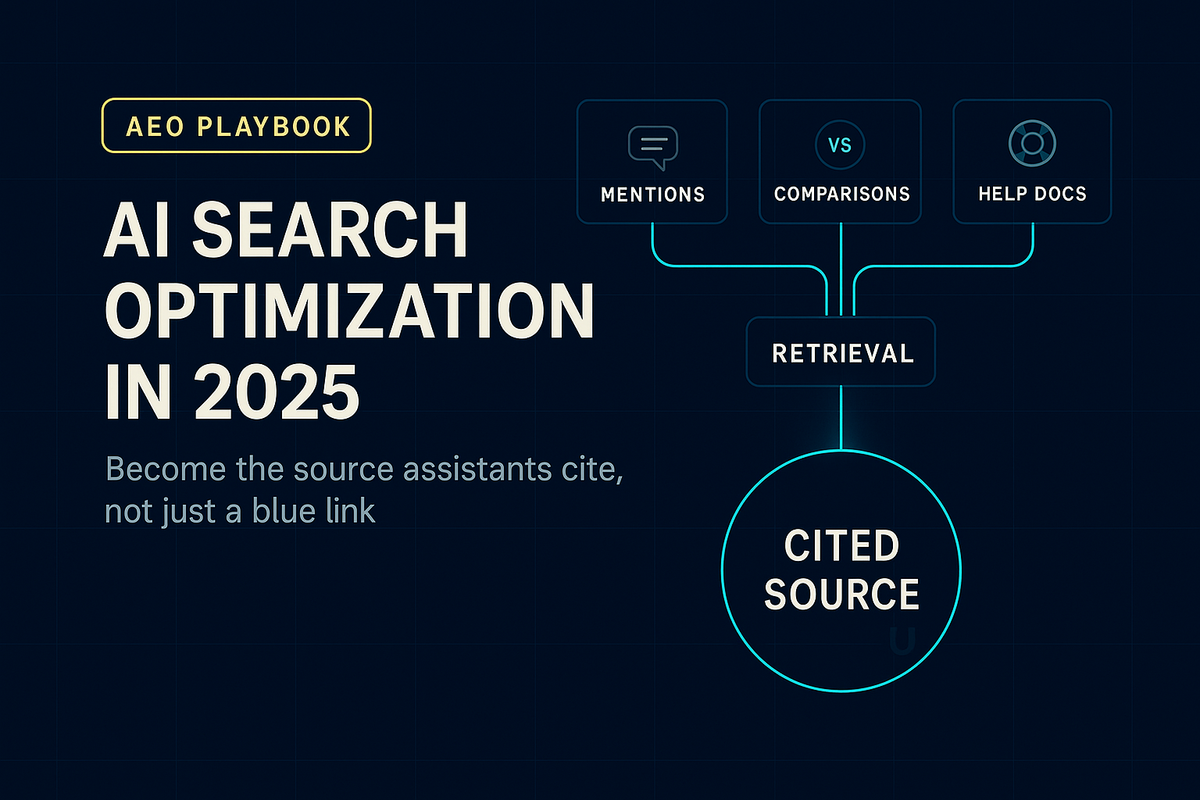AI Search Optimization in 2025: A Practical Guide to Answer Engine Visibility
How to become the source AI cites, with off-site authority, fresh structured content, and technical fixes that help both users and bots.

AI search is reshaping how people discover, compare, and decide. The goal is simple, become the cited source inside AI answers, not just the blue link below them.
The 3 ways to influence AI visibility
1) Show up in training data
Large language models learn from public corpora, books, web archives, documentation, research, code, and community content. You cannot force inclusion, but you can increase your brand’s surface area in sources models consistently ingest. Publish crawlable research and whitepapers, add clear context to public GitHub repos, maintain accurate author and product pages, and contribute high quality references where appropriate, such as knowledge bases and reputable forums. Training cadences differ and are opaque, so treat this as a long game and focus on quality and clarity.
2) Win retrieval, be the page assistants cite
When an assistant does not know the answer from memory, it runs live searches and cites sources. You win here by ranking with helpful, definitive content and by being mentioned across credible third party pages that assistants prefer to pull from. Practical support tools include Surfer and Frase for briefs and on page structure, and Outrank for scalable third party coverage.
3) Skip shortcuts
Massive, machine written walls of text may earn short lived citations and long term distrust. Google has years of anti spam experience and AI tools are getting stricter. Optimize for humans first, and you will be safer as systems evolve.
Off site mentions are the new backlinks
In answer engines, what others say about you matters as much as what you host yourself. Consistent, factual mentions of your brand, products, and use cases across respected domains build semantic authority. Large scale analyses indicate that branded web mentions strongly correlate with AI citation frequency. See Ahrefs’ coverage of AI SEO statistics and their summary on AI overview visibility for directional data.
Do the durable work, earn placements in honest comparisons, category roundups, expert reviews, user generated discussions, and reputable directories. When possible, supply original data, clear screenshots, and concise explanations so editors and curators can cite you accurately.
Want a primer on this approach, see Generative Engine Optimization: A Starter Playbook.
What content AI systems prefer to cite
Citation behavior does not mirror the classic top ten. Studies have shown a relatively low overlap between the links assistants cite and Google’s first page for the same prompt, which implies assistants decompose prompts into simpler searches and combine multiple sources. See Ahrefs’ analysis of overlap in AI citations here.
Formats assistants commonly favor:
- Informational guides, how to content, explainers, checklists
- Comparisons, best, top, X vs Y, alternatives, buyer’s guides
- Help and FAQ pages with direct, structured answers
- Research and PDFs that include original data and methods
- Core site pages, pricing, product overview, about, when they state facts cleanly
- YouTube, accurate transcripts and clear descriptions are often parsed and cited
Formats assistants tend to under cite:
- Faceted listings and generic collection pages
- Interactive tools that require client side rendering
If you are building from scratch, use a structured brief process that bakes in entities and BLUF writing. Our workflow, SEO Content Briefs in 2025, shows how to do this quickly.
How assistants actually search, fan out queries
Assistants rarely paste a user’s wording straight into a search engine. They break prompts into multiple simpler queries, then fuse the results. This creates new opportunities to surface as a citation even if you do not mirror the top ranking pages for the head term. Structure sections and FAQs to cover adjacent intents, pricing and limits, setup time, best for small teams, regulated industries, offline use, common alternatives, and so on.
The practical takeaway, create topic clusters that answer the core query and the likely near neighbors in one hub. Distinct, well reasoned takes can be rewarded when assistants diversify sources.
Keep key pages fresh and easy to parse
Freshness matters. Large scale research indicates assistants bias toward newer sources on fast moving topics. See Ahrefs’ study on assistant citation freshness here. Do not update everything at once, prioritize pages already earning search or assistant visibility, high value help docs, and definitive guides.
- Bottom line up front, open each page and section with the direct answer
- Declarative sentences, say what is true as you see it, then prove it
- Short paths to meaning, avoid long, winding sentences
- Entity richness, name products, features, standards, audiences, scenarios
- Periodic context in long docs, restate scope and audience at sensible intervals
Handle hallucinated URLs and entity drift
Assistants sometimes invent plausible URLs, which sends users to 404 pages. This is common enough to warrant a simple hygiene loop. Monitor analytics for 404s from assistant referrers, create the expected page when it makes sense, or redirect to canonical locations. Ahrefs discusses link hallucinations and 404s in this analysis.
Also watch for entity drift, when assistants misstate features or history. Keep help docs, about pages, and product explainers clear, up to date, and easy to cite.
Beware of JavaScript rendering gaps
Many AI crawlers capture initial HTML and do not execute JavaScript. If your critical content only appears after client side rendering, assistants may miss it. See Vercel’s technical rundown on AI crawler behavior here.
- Prefer server side rendering or static prerendering for critical pages
- Ensure key headings, copy, and schema exist in HTML before JS runs
- Include accurate transcripts for video or audio content
SEO and AEO, overlap and divergence
SEO and answer engine optimization share foundations, crawlability, quality, authority. The tactical aim is different, SEO seeks rankings, AEO seeks to be cited inside answers. The good news, category A tactics help both, off site mentions, honest comparisons, robust help docs, research, video transcripts, clean HTML, and internal linking.
Keep classic SEO in shape while you optimize for AI. Google remains dominant in user behavior. See SparkToro’s clickstream context here, and track how Google’s AI Overviews footprint changes by category with BrightEdge guidance.
For a pragmatic view on blending both, read Solo SEO in the SGE Era.
Tool stack, three practical helpers
- Surfer, entity aware briefs and on page optimization that align with both SEO and assistant preferences
- Frase, brief driven outlines, FAQ extraction, and structural help for BLUF sections
- Outrank, scalable third party coverage and mentions on credible domains assistants like to cite
Disclosure, some links above are affiliate links, which may earn us a commission at no extra cost to you.
Final thoughts
You do not need tricks. You need clear, recent, entity rich pages that answer fast, credible third party mentions, and technical foundations that let assistants fetch and understand your content. Do the durable work that helps humans and machines, then measure and iterate.
Behavior and training sets change over time, so treat the data above as directional and re check quarterly. Start by refreshing the three pages most likely to be cited today, a definitive guide, a comparison, and a help doc, then expand your off site footprint where your audience already looks for answers.





